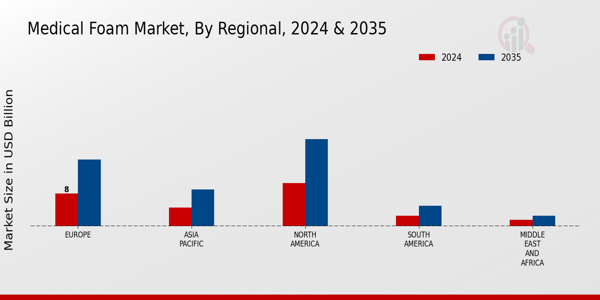Medical Foam Size
Medical Foam Market Growth Projections and Opportunities
The medical foam market is influenced by several key factors that shape its growth and dynamics. Medical foams are versatile materials used in various healthcare applications, including wound care, medical packaging, orthopedic support, and patient positioning devices.
One significant driver of the medical foam market is the increasing demand for advanced wound care solutions. Medical foams are used in wound dressings and bandages due to their ability to provide cushioning, moisture management, and protection against infection. With the rising prevalence of chronic wounds, such as diabetic ulcers and pressure sores, the demand for innovative wound care products continues to grow, driving the market for medical foams.
Another important factor is the aging population and the growing incidence of chronic diseases. As the global population ages, the incidence of chronic conditions such as diabetes, cardiovascular diseases, and obesity increases. These conditions often require long-term care and management, leading to a higher demand for medical devices and products, including foam-based orthopedic supports, cushions, and prosthetics.
Technological advancements in foam manufacturing and processing play a crucial role in driving market growth. Innovations such as advanced materials, enhanced manufacturing techniques, and customization capabilities allow manufacturers to develop medical foams with improved performance, comfort, and durability. These technological advancements enable the production of specialized foams tailored to specific medical applications, expanding the market potential.
Regulatory standards and quality requirements are essential market factors, particularly in the healthcare industry. Medical foams must comply with stringent regulatory guidelines and standards to ensure safety, efficacy, and biocompatibility. Compliance with regulations such as FDA approval in the United States and CE marking in Europe is essential for market access and product acceptance, influencing manufacturers' strategies and investments.
The growing focus on infection control and patient safety drives the demand for antimicrobial and hypoallergenic medical foams. Hospitals and healthcare facilities are increasingly adopting infection prevention protocols to reduce the risk of healthcare-associated infections (HAIs). Medical foams with antimicrobial properties help prevent bacterial colonization and contamination, making them essential components in wound care and patient support products.
Environmental sustainability and eco-friendly initiatives are becoming increasingly important market factors. Healthcare organizations and consumers are seeking products with minimal environmental impact and sustainable manufacturing practices. Manufacturers are responding by developing bio-based and recyclable medical foams, reducing their carbon footprint, and incorporating eco-friendly materials into their products.
Market consolidation and strategic partnerships are shaping the competitive landscape of the medical foam market. Major players in the industry are expanding their product portfolios, investing in research and development, and acquiring smaller companies to strengthen their market position. Strategic collaborations between manufacturers, healthcare providers, and research institutions drive innovation and promote the adoption of advanced medical foam solutions.
Economic conditions and healthcare spending also influence the medical foam market. Economic growth, healthcare infrastructure development, and government healthcare policies impact the demand for medical devices and products. Changes in healthcare reimbursement policies and insurance coverage affect healthcare purchasing decisions, including the selection of medical foam products.
Consumer preferences and patient comfort are important considerations in the medical foam market. Patients and healthcare professionals value products that offer comfort, support, and ease of use. Medical foams that are lightweight, breathable, and conformable enhance patient comfort and compliance, driving their adoption in various healthcare applications.














Leave a Comment